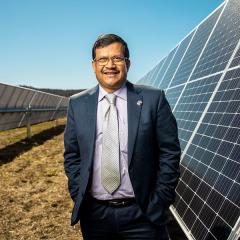The switch has been flicked on one of Queensland’s largest behind-the-meter battery storage system, capable of powering 175 average homes for 24 hours.
The Tesla Powerpack battery system delivers 2 megawatt-hours of energy storage and will help The University of Queensland meet its renewable energy goals.
UQ Chief Operating Officer Greg Pringle said the large-scale battery and inverter system can store enough energy to power up to 10 per cent of the St Lucia campus for two hours.
“To put it into perspective, the university uses a large amount of electricity to power lecture theatres, laboratories, libraries and other facilities for more than 50,000 students and staff,” Mr Pringle said.
“We are on track to become the first university in the world to offset 100 per cent our electricity use using our own renewable energy generation.
“This battery storage system will help us to support that ambitious goal - it will complement the Warwick Solar Farm which is nearing completion, and recently won a coveted Australasian Green Gown Award.”
The $2 million investment, funded through the earnings generated from UQ’s rooftop solar arrays, has the energy storage equivalent of around 500,000 standard AA batteries.
UQ’s Energy and Sustainability Manager Andrew Wilson said the battery storage system was a key component of the University’s plan to become an active participant in the energy market from the start of 2020.
“We can now trade in the wholesale energy market – the goal is to charge when prices are low and renewable energy is abundant, and then discharge when demand and prices are high,” Mr Wilson said.
“To facilitate this we are using a custom control system which was developed by one of our engineering graduates to monitor wholesale energy prices around the clock and automatically control our trading of energy.
“Combined with the other services we are able to provide to the grid such as frequency control during faults, we expect the battery system to earn around $250,000 in revenue each year.”
UQ Chair in Sustainable Energy Futures Professor Peta Ashworth said battery storage systems would play a significant role in the future.
“With the rising cost of electricity, more and more householders are investigating and investing in solar and battery systems for their home,” Professor Ashworth said.
“These systems allow them to store the solar collected during the day, and use the energy when prices are higher during peak evening times.
“Looking into the future, with cheaper consumer battery systems becoming available, households may follow UQ down the path of buying and selling energy in real time.”
The public can view UQ’s battery activity and performance in real time, as well as access historical data, via a dedicated webpage – http://dashboards.sustainability.uq.edu.au/engineering-precinct-battery/interactive/
Media: Andrew Wilson, a.wilson@pf.uq.edu.au, +61 7 3365 1935; UQ Communications, communications@uq.edu.au, 07 3365 1120.



